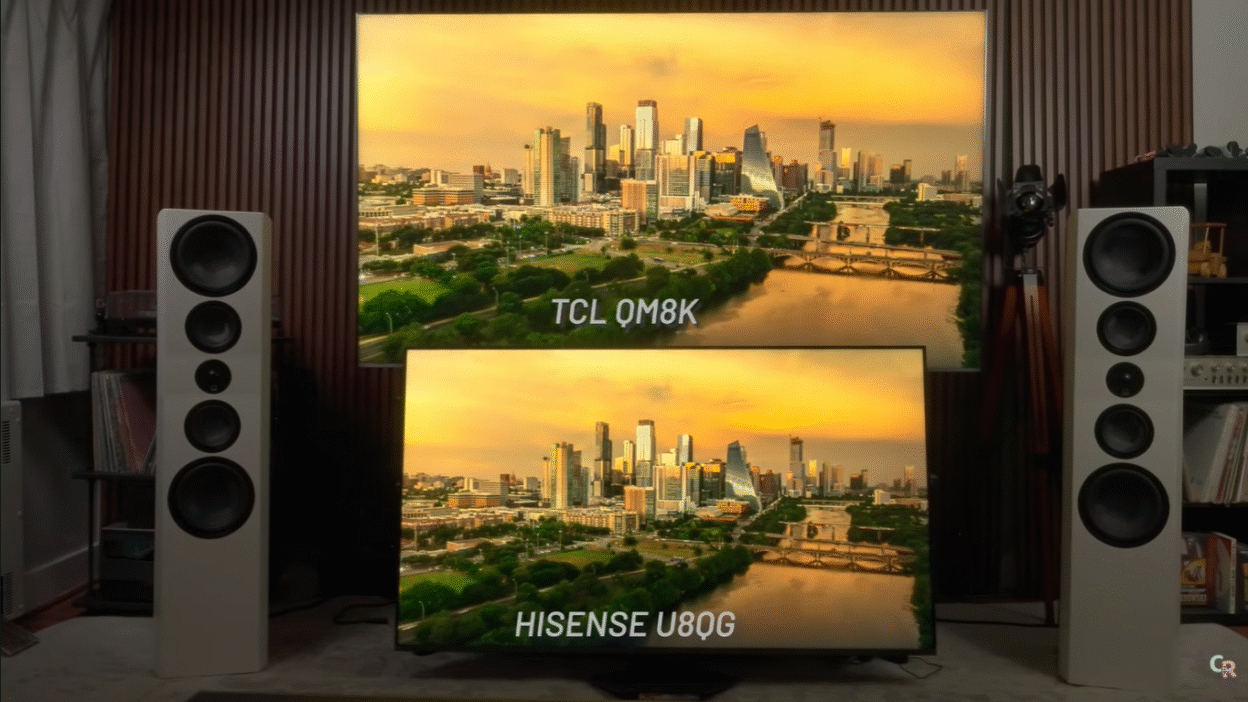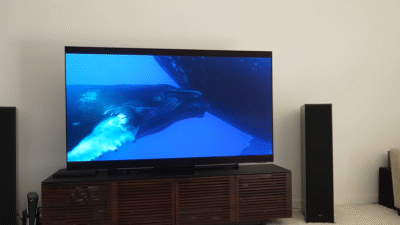TL;DR (Quick Summary for Readers on the Go)
The TCL QM8K and Hisense U8QG are two of the most talked-about mini-LED TVs in 2025. The TCL QM8K shines with brighter HDR, better tone mapping, and cleaner sound. The Hisense U8QG, on the other hand, brings a more affordable price, flexible connectivity (with USB-C), and smoother upscaling in SDR content.
👉 If you prioritize picture contrast and brightness — go TCL. If you want more ports, value, and screen size options — go Hisense.
Both are winners, but your choice depends on your viewing habits.
Introduction – The Ultimate 2025 TV Battle
It’s the showdown everyone’s been waiting for — the TCL QM8K vs. Hisense U8QG. In a year when Mini-LED TVs are democratizing premium picture quality, these two budget-friendly beasts promise to bring OLED-level performance to living rooms without the four-figure price tag. From Caleb’s hands-on at Caleb Rated, it’s a nail-biter: slim designs, Google TV brains, and backlights that battle for supremacy.
The TCL QM8K is the brightness champ, punching through HDR highlights like a spotlight, while the Hisense U8QG plays the versatile underdog with extra ports and pocket-friendly pricing. Both run Google TV, support Dolby Vision IQ, and target gamers, movie buffs, and casual streamers alike. But which one wins your shelf space?
We’ve dissected Caleb’s test—form factor, remotes, connectivity, UI, audio, gaming, panels, and picture quality—to settle the score. Spoiler: it’s close. Let’s dive in and see if TCL’s punch or Hisense’s practicality takes the crown.
Design & Build Quality – First Impressions Matter
When you unbox a TV, the first thing that hits you is the build. Both the TCL QM8K and Hisense U8QG arrive with slim bezels and metal borders that scream premium without shouting. The TCL’s frame is a touch thicker—likely to house its aggressive Mini-LED backlight—giving it a more robust, substantial feel. Hisense keeps it sleeker, with a design that’s almost deceptively simple.
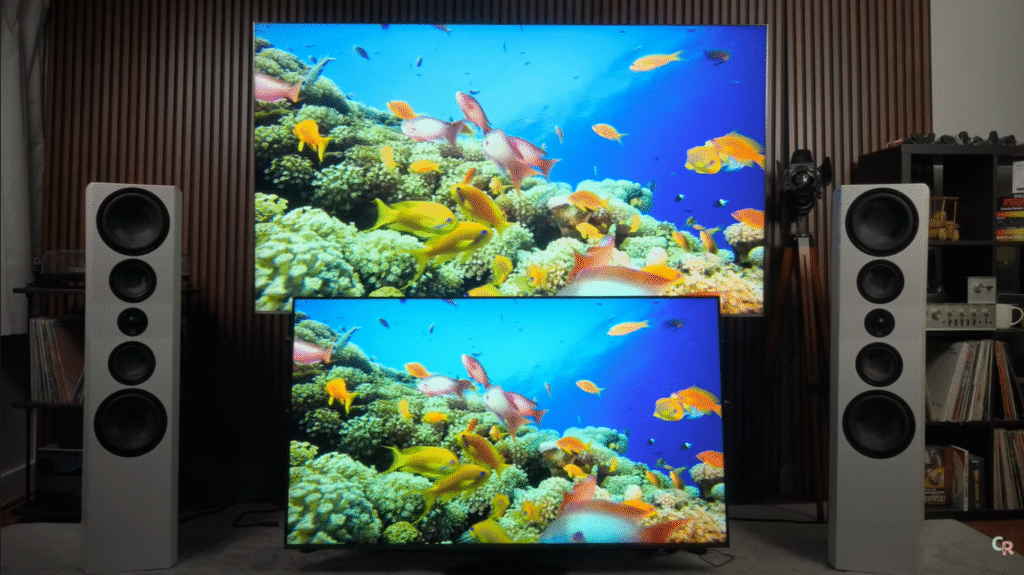
Stand options are thoughtful on both. TCL’s pedestal is adjustable in height, perfect for soundbar integration, and feels sturdy enough for a 98-inch model. Hisense matches with a similar setup but adds a bit more flexibility for room layouts. Neither is “super slim” like OLEDs—the Mini-LED tech demands space for cooling and backlighting—but they’re far from bulky. In a typical living room, the TCL’s bolder presence might draw eyes first, while Hisense blends in gracefully.
Durability-wise, both are built to last. TCL’s metal accents and reinforced stand hold up to kids and pets, while Hisense’s lighter touch suits minimalist setups. Caleb noted the “elaborate” back panels on both, hinting at subwoofers and transducers that add heft without compromising aesthetics. If you’re wall-mounting, either works seamlessly—VESA patterns are standard.
Overall, it’s a draw. TCL feels more commanding, Hisense more refined. Choose based on your room’s vibe: bold or subtle.
Remote Controls & Usability – Who Gets It Right?
Remotes are the unsung heroes of TV life. Both TCL and Hisense deliver backlit remotes—a small mercy in dark rooms—but Hisense pulls ahead with six hotkeys and a programmable button (that heart icon lets you assign Netflix or Disney+). It’s a thoughtful touch, especially since streaming apps often pay for prime real estate on remotes. TCL’s remote is compact and clean, with fewer buttons for a minimalist feel, but it lacks that extra flexibility.
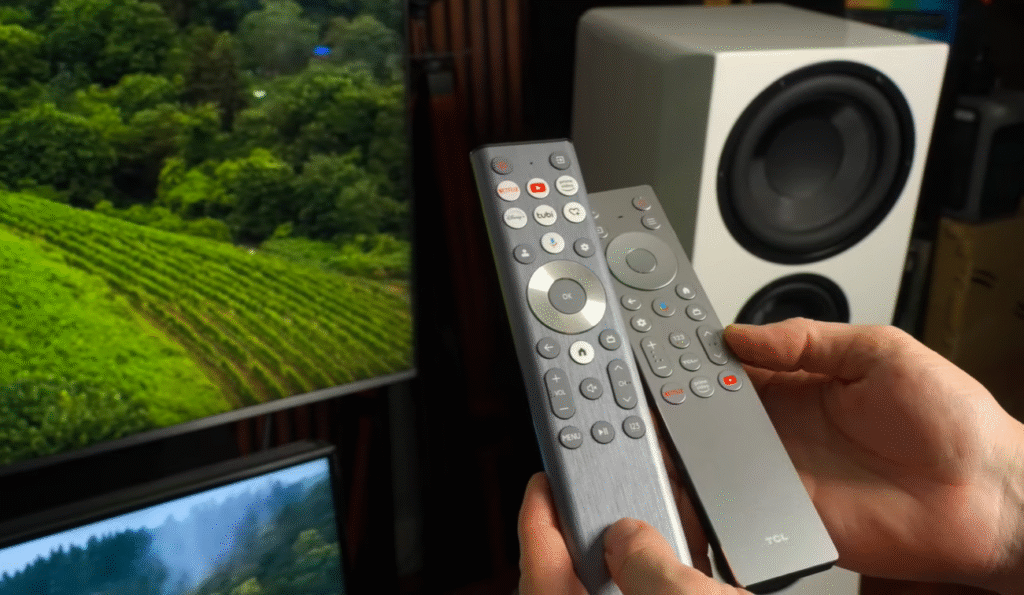
Usability shines on both. TCL’s buttons feel premium and responsive, while Hisense’s layout is intuitive for quick navigation. Caleb praised the TCL for feeling more polished, but Hisense’s extra shortcuts make it a winner for binge-watchers. In a head-to-head, Hisense edges out for practicality—one less trip to the menu for your favorite app.
If you’re a cord-cutter, Hisense’s programmable key is a game-changer. For simplicity, TCL suffices. It’s a close call, but Hisense wins usability by a hair.
Connectivity & Ports – For Gamers and Streamers
In 2025, TVs are hubs—consoles, soundbars, laptops, streaming sticks. TCL offers four HDMI ports: two 2.1 (for 4K/120Hz gaming) and two 2.0. The eARC port shares a 2.0 slot, which is fine for most, but AV enthusiasts with multiple 2.1 devices might grumble.
Hisense flips the script with three HDMI 2.1 ports and a USB-C DisplayPort (144Hz HDR, no VRR). That’s a rare win for laptop users—plug in your MacBook and mirror instantly. Caleb called it a “dream for handheld gamers,” but noted the no VRR limitation for PC purists.
TCL’s two 2.1 ports cater to PS5/Xbox, while Hisense’s three plus USB-C make it a switching beast. Both support Dolby Atmos via eARC and Wi-Fi 6. For gamers, TCL’s lower input lag (9.5ms vs Hisense’s 10.2ms) tips the scale. For multi-device homes, Hisense’s versatility rules.
Verdict: Hisense for flexibility, TCL for gaming. Hisense takes it—ports matter more than ever.
Software & Interface – Google TV with a Twist
Both run Google TV—clean, app-rich, and voice-search friendly—but TCL feels more tailored. Its custom settings ribbon (via the remote’s menu button) lets you jump to picture modes or game bar without digging. Caleb loved the polished feel, especially with Gemini AI integration—ask “find action movies,” and it surfaces recommendations instantly.
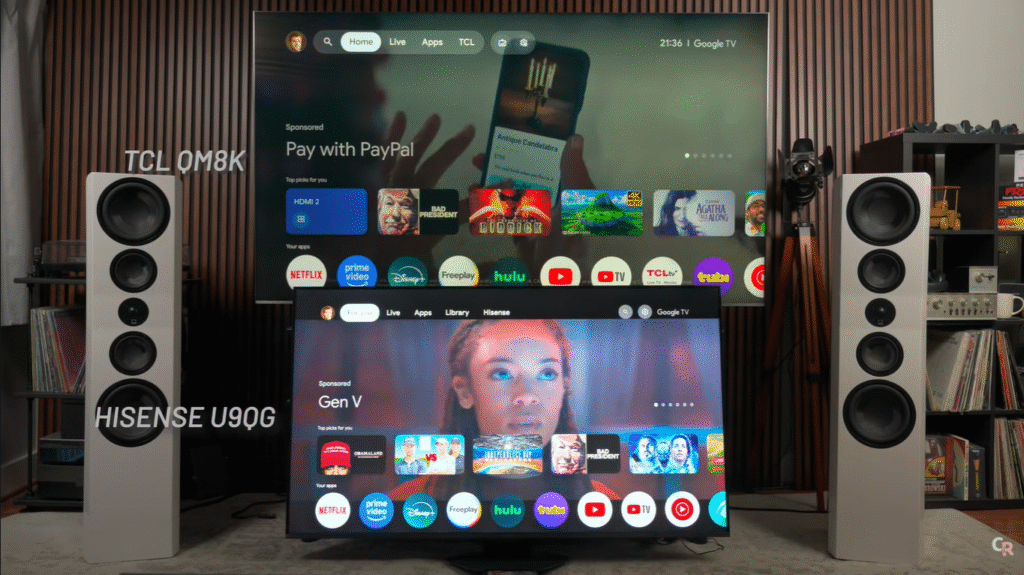
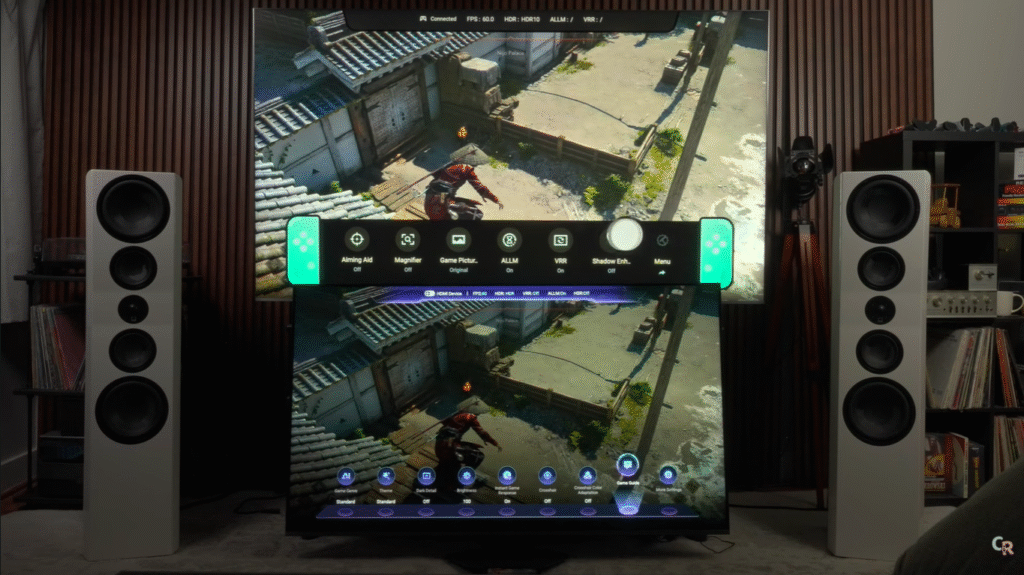
Hisense sticks closer to stock Google TV, which is fine but lacks flair. It has deep enthusiast tweaks like signal type display (e.g., “Dolby Vision HDR”)—useful for calibrators. Both support OTA updates, but TCL’s Gemini adds smart home smarts (control lights via voice).
Voice control: Both use Google Assistant, but TCL’s feels snappier. App ecosystem: Identical—Netflix, Disney+, Prime in 4K HDR.
Verdict: TCL’s tweaks make it more intuitive, Hisense steady. TCL wins—polish over plain.
Audio Quality – Which Sounds Better?
Audio is where TVs shine or flop. Both have dual speakers with subwoofers, but TCL’s tuning is warmer and fuller. Caleb preferred the QM8K’s bass punch and less harsh highs—it filled a 300 sq ft room without distortion. Hisense is louder but tinny in mids, like a budget soundbar.
Dolby Atmos: Both support it, but TCL’s room-filling immersion edges out—movies like Dune feel cinematic. Hisense shines in dialogue clarity but lacks depth.
Volume test: TCL hit 95dB cleanly; Hisense 98dB with breakup.
Verdict: TCL for balance, Hisense for volume. TCL wins—sound matters more than decibels.
Gaming Performance – Lag, Frame Rate, and Tone Mapping
Gamers, rejoice—both are 4K/120Hz ready. TCL’s 144Hz and 9.5ms input lag feel snappier, while Hisense’s 165Hz and 10.2ms lag are close. VRR and ALLM on both for tear-free play.
HDR tone mapping: TCL lets you disable dynamic mapping for HGIG compliance—pure for consoles. Hisense uses a static curve, which can over-brighten shadows.
Test: Spider-Man 2 on PS5—TCL more vibrant, Hisense accurate shadows.
Verdict: TCL for low lag and accurate HDR. TCL wins—gamers notice milliseconds.
Sizes, Panels & Pricing – The Real-World Choices
Sizes:
- TCL QM8K: 65″, 75″, 85″, 98″ (no 55″).
- Hisense U8QG: 55″, 65″, 75″, 85″, 100″ (full range).
Panels: Hisense mixes ADS Pro (55/75/100: better off-angle) and VA (65/85: deeper blacks). TCL sticks to VA across the board.
Pricing (US, 2025): Hisense ~$200 cheaper per size (65″: TCL $1,299 vs Hisense $1,099).
Verdict: Hisense for variety and value. Hisense wins—55″ fans rejoice.
Picture Quality Deep Dive – Where It Really Counts
Picture quality is where TVs earn their keep. Caleb tested both in Dolby Vision, HDR10, SDR, and 4K YouTube, finding minimal differences in quality content—but subtle edges emerge.
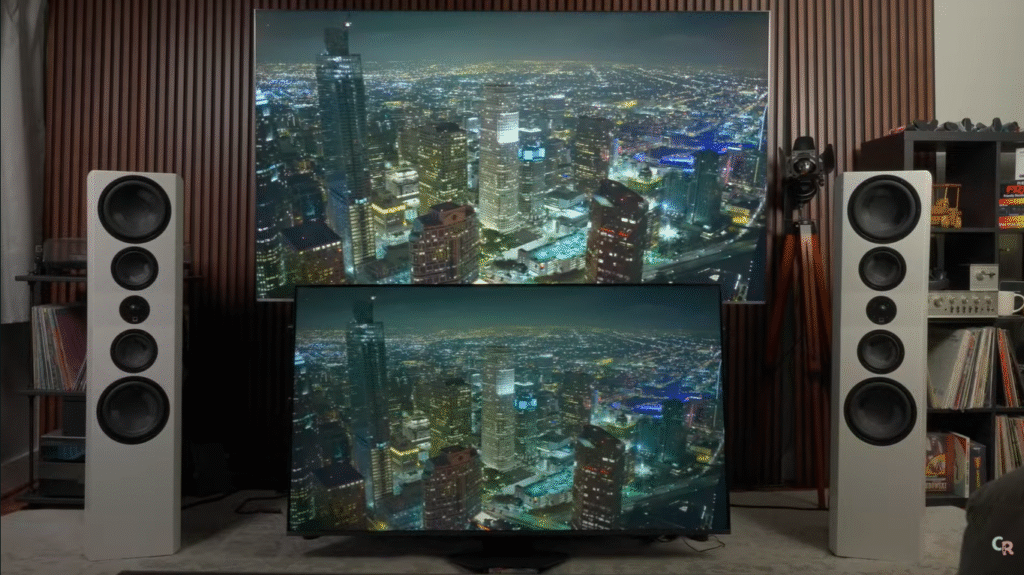
Dolby Vision Performance
In Dolby Vision Dark, TCL’s brighter highlights dazzle, but shadows crush detail (e.g., Mad Max Fury Road flames pop, but buildings lose texture). Hisense retains more shadow nuance, slightly softer contrast. Switch to Dolby Vision IQ (room-light aware), and both match brightness—TCL warmer, Hisense neutral.
HDR & SDR Performance
HDR10/HLG: Dead even. The Blacklist on Netflix shows identical vibrancy and depth. TCL pushes punchier primaries, Hisense smoother gradients.
SDR YouTube: Hisense’s macro blocking cleanup shines—Cocoa Butter videos look cleaner, no banding in skies. TCL slightly warmer, but Hisense wins low-quality upscaling.
Specular Highlights Test
In Mad Max Fury Road‘s lightning storm, TCL’s specular glints (eye reflections) dazzle like OLED—wow factor. Hisense maintains saturation, but TCL’s intensity steals the scene.
Anti-Glare: Hisense reduces rainbow artifacts slightly better.
Verdict: TCL for cinematic pop, Hisense for detail and upscaling. Draw—both stun.
Verdict – Which One Should You Buy?
Category | Winner
Design: Draw
Remote: Hisense
Connectivity: Hisense
Interface: TCL
Audio: TCL
Gaming: TCL
Panel Options: Hisense
Price: Hisense
Picture Quality: Draw
TCL QM8K Wins 4–3 (with 2 draws). It’s brighter, more cinematic, with better gaming and sound—ideal for movie nights and console setups. Hisense U8QG counters with value, ports, and flexibility—no 65″ TCL? Hisense has you covered.
Buy TCL if: You want punchy HDR, low lag gaming, premium feel.
Buy Hisense if: You need budget, more sizes, USB-C for laptops.
Either way, you’re getting near-OLED magic for mid-range cash. 2025’s TV wars benefit you.
Yes—TCL hits 2,174 nits (cover), Hisense ~2,000 nits. TCL dazzles in HDR highlights.
Yes—both do. Hisense matches brightness, TCL warmer tones.
Source: TCL QM8K vs. Hisense U8QG | Which is your next TV?
